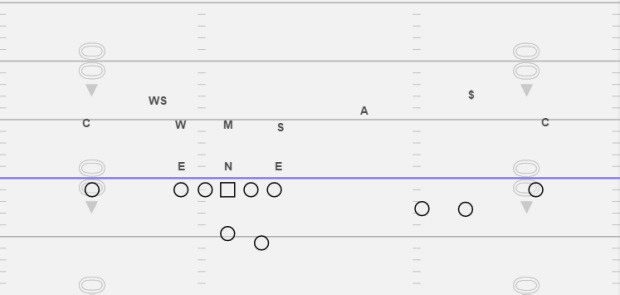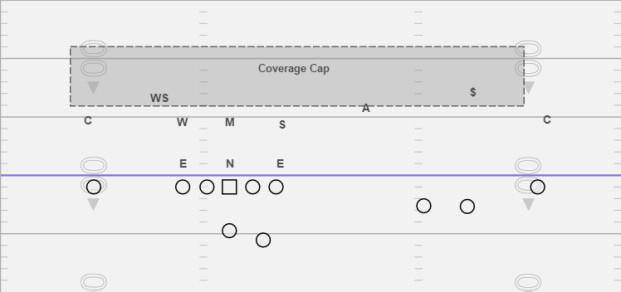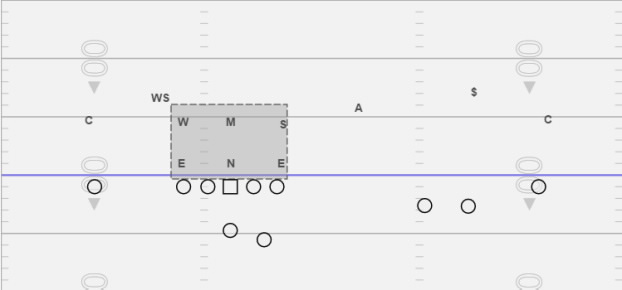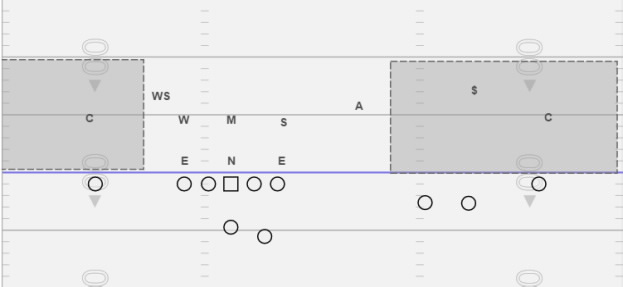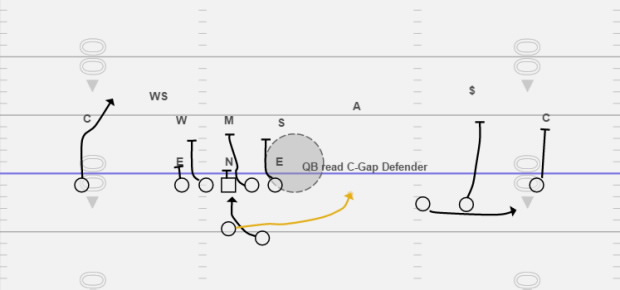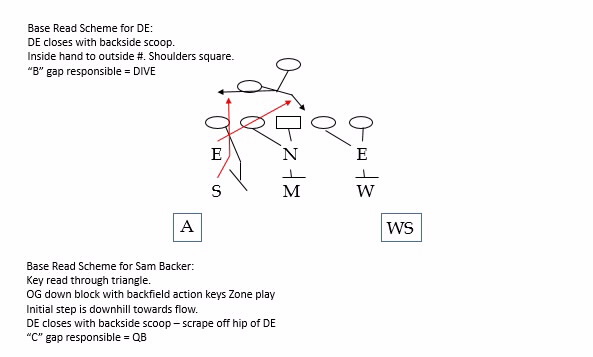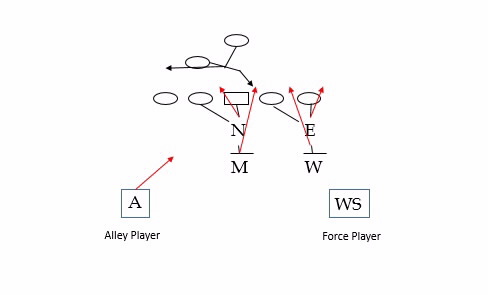Point/Counterpoint: First play of the game – First and Ten on the 20-Yard Line - Trips Right vs. 33-Stack from Left HashVoting Results
Offense
Votes: 499
Defense
Votes: 499
Diagram #1 - Trips Right vs. 33-Stack from Left Hash - Pre Snap Alignment.
The play we are going to open up the game with on first and 10 from the minus 20 yard line will be our base inside zone scheme. We are going to pair our inside zone with any number of game planned run pass options that are built into the play call. This gives our quarterback a place to go with the football if we do not have favorable numbers to run the football. This allows us to limit our at the line checks allowing us to play at a faster tempo because all of our base run plays have two or three different options that can be built into the base play. The first thing we ask our quarterback pre-snap is to scan the defensive alignment. We look at three key areas of the defense to examine where we can best attack weakness in the defensive structure. Our quarterback will first look at the coverage cap of the defense and determine if it is an open or closed cap. In this situation we are facing a split safety coverage, so we would identify this coverage as an open coverage (middle of the field open) pre-snap. There is the potential for the Apex defender to become a deep safety but at his alignment pre-snap (7 yards) we consider him a second level defender (Diagram 1). We will enter the game with one of two thought processes: 1) Maintain Box integrity and force the opponent to throw the ball. 2) Break the Box and force the opponent to prove they can run the ball against coverage defense. Obviously this depends on the opponent’s strengths/weaknesses and what we want to take away. For practical purposes we will assume that our game plan is to force the throw and keep the Box intact. By virtue of defense alignment we understand that we are “inviting” the bubble screen and will react accordingly.Whereas the inside zone concept is usually good against odd-stack teams, we believe we are better suited to defend this scheme because of alignment and number of defenders in the Box. As mentioned in the philosophy of the defense, we hope to confuse QB pre snap read by 3 high safeties. Although the initial read is Safety open, we can play multiple coverages out of the look (Diagram 2) Diagram 2- Pre-Snap Coverage Cap with Defensive alignment Our quarterback will then scan the interior box (Diagram 3) to determine front. Our center would make a stack call indicating that the defense is aligned in a six man box with a 3-3 stack alignment. The quarterback will then scan the alignment of the defense in what we call the perimeter box. The perimeter box extends from 3 yards inside of our closest wide receiver and extends to the sideline six yards deep (Diagram 4). We look for numbers and leverage in the perimeter box to attack with our run pass option variations. In this particular defensive alignment we are facing a six man box which is favorable for our inside zone play so we would not have to check to a different concept pre-snap. In the perimeter box to the single wide receiver side, the defense has a corner and the weak safety on the fringe of the interior box. We do not have numbers against this alignment; however to the field we have both numbers and leverage advantage to our trips alignment as the defense is attempting to Apex our inside slot. If this alignment remains unchanged pre-snap our quarterback will have the option to throw the football to the perimeter quickly depending on what run pass option we deploy. The quarterback also knows that he has the ability to run the inside zone play based on the six man interior box count. Diagram 3- Interior Box
Diagram 4 – Perimeter Box The Perimeter Box is what we are willing to concede to start the game. Again, game plan will either maintain Box integrity or will play coverage to take away quick game. In this scenario we have decided to maintain Box integrity so the first adjustment will be to slide coverage in the event the offense is able to take advantage of the perimeter quick game. In our base inside zone concept (Diagram 5) we will be attempting to read the C-gap defender to the backside of the play. This can create some challenges due to the nature of the gap exchange common with an odd stack defensive front. Teams will often run a pinch scrape exchange where they will attack the b-gap with the defensive end and scrape the Sam backer outside. We teach our quarterback if his read becomes cloudy that he will hand the football off. Diagram 5- Base Inside Zone Concept vs. 33 Stack Defense Thought process for QB read: We start with our base “Read Scheme” concept. DE’s responsibility is determined by the OT’s steps. In this case, a “down” block will cause the DE to close the “B” gap which will immediately take him to dive. The stack backer
keys OG
through backfield flow. It is his responsibility to “make the DE right”
at all times. Flow away with DE closing will allow the backer to “scrape
fit” off the DE’s hip. He becomes a “C gap”
player which puts him on the QB. In this scenario, if the QB is reading the DE, the end result should be to pull the ball. The stack backer should be left unblocked with a clean path to the QB. This should necessitate an offensive adjustment as to whom the read will be moving forward (Diagrams 6 and 7). Diagram 6
The front side of the defense should “gap out” based on the fits of the read scheme Diagram 7 We will attempt to “build a wall” that will force the back east/west to our perimeter support. The backside safety (WS) should “piggyback” the stack backer as he runs the “Alley” helping to take away any pull, cutback, reverse etc. The Frontside Safety should act as a “Force Player” attacking the upfield shoulder of the ball carrier forcing the ball to bounce hard to the perimeter or cut back into the heart of the defense. In either case we feel the additional Alley and Force player gives us the advantage versus the run game.
In this particular situation we will pair our inside zone run concept with a slant by the single WR and a quick screen to the trips side. To the single WR side his rule is to run a three step slant keying the weak hash safety. If the safety remains on the hash, our receiver will turn his quick slant into a “take two” concept that will occupy both the corner and the weak safety on the backside (Diagram 8). If the weak safety inverts into the box pre-snap our WR will be alert for the ball to be delivered by the quarterback as the single WR slants skinny into the vacated area of the field (Diagram 9). If the quarterback determines that he is going to throw the skinny slant to the backside pre-snap due to weak safety invert we make a special call that tells our backside tackle to lock on or block the read key so that the quarterback does not get hit by the unblocked defensive end while throwing the slant. 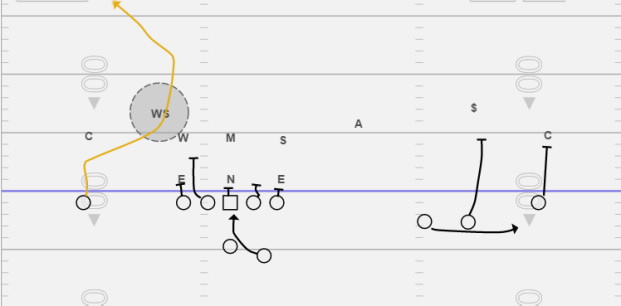
Diagram 8 - Backside – Take Two
Getting back to the initial game plan, we have decided to concede the frontside bubble. From a QB progression standpoint we believe we have taken away the backside slant by virtue of safety alignment. This will be an adjustment the offense will make depending on how they see us defending this play or how fast the WS plays the run action. We will need to have coverage adjustments ready depending on how the attack this later in the game. The QB’s first progression should be to throw the bubble. Again, we will attempt to “Force” the bubble with our frontside Safety ($) back into our “Inside Fill” player or the middle safety (Adjuster). Again, this will be the first adjustment we will make depending on how the offense decides to attack the perimeter.
Diagram 9 - Backside Skinny vs. Weak Safety Invert To the trips side of the formation we feel that we have leverage to run a bubble screen or a quick screen concept. In this situation our quarterback will throw the football immediately to our inside slot receiver on the bubble screen as he has leverage on the apex defender. Our two outside wide receivers will block the most dangerous defenders. If the ball is not delivered to the bubble screen and the quarterback gets into the inside zone read phase of the play, the bubble receiver will stay and the line of scrimmage at the numbers awaiting a potential “pop out” by the QB if he keeps the ball on the zone read and is forced by the apex defender (Diagram 10). Our inside zone concept paired with our built in answers should give us a great opportunity to gain 4+ yards on first down and allow us to get into a nice rhythm for our tempo offense to start the game. 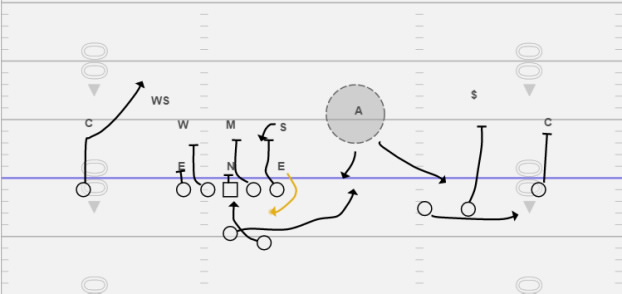
Diagram 10 – QB Reading Apex Defender after Pull Read on Inside Zone The Zone Read should be negated by the read scheme concept of the stack backer which should protect the Apex player (Adjuster) from coming into conflict. In theory he should be able to slow play the run game in order to help on bubble. To recap: 1) We will determine how we want to initially defend the offense based on tendency and personnel strengths/weaknesses. This will either result in maintaining Box integrity to negate the run or to play coverage and see if the offense will be able to take advantage of numbers in the Box. 2) We understand the weaknesses to both approaches and have adjustments made prior to the game based on how the offense finds success. 3) In this scenario we have decided to concede the perimeter bubble in order to neutralize the run game and the backside passing game. This is our first adjustment concern. 4) We understand they will be watching how the backside safety plays run early to determine what they want to do backside. This is another adjustment concern. 5) It is important that we understand who the QB reads (DE/Stack Backer) in order to adjust “B” gap “C” gap responsibilities accordingly. As Coach Liotta pointed out, they hope to gain a quick 4 yards on first down to get themselves into a good rhythm. It is our responsibility to take them out of that rhythm by forcing a second and long situation. How they attack and how we adjust to that method of attack will determine the rhythm of the game.
|
|
| HOME |
MAGAZINE |
SUBSCRIBE | ONLINE COLUMNISTS | COACHING VIDEOS |
Copyright 2026, AmericanFootballMonthly.com
All Rights Reserved


